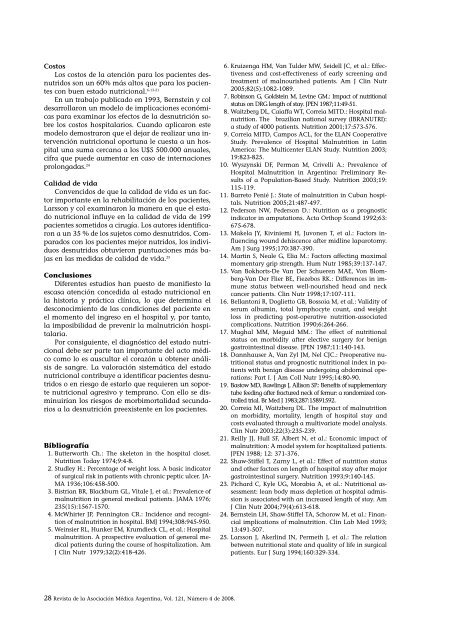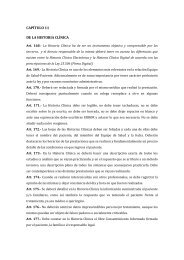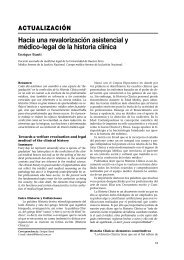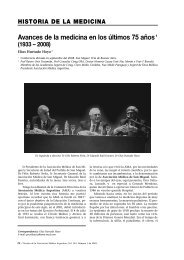Desnutrición hospitalaria: una patología subdiagnosticada
Desnutrición hospitalaria: una patología subdiagnosticada
Desnutrición hospitalaria: una patología subdiagnosticada
You also want an ePaper? Increase the reach of your titles
YUMPU automatically turns print PDFs into web optimized ePapers that Google loves.
Costos<br />
Los costos de la atención para los pacientes desnutridos<br />
son un 60% más altos que para los pacientes<br />
con buen estado nutricional. 6-13-21<br />
En un trabajo publicado en 1993, Bernstein y col<br />
desarrollaron un modelo de implicaciones económicas<br />
para examinar los efectos de la desnutrición sobre<br />
los costos hospitalarios. Cuando aplicaron este<br />
modelo demostraron que el dejar de realizar <strong>una</strong> intervención<br />
nutricional oport<strong>una</strong> le cuesta a un hospital<br />
<strong>una</strong> suma cercana a los U$S 500.000 anuales,<br />
cifra que puede aumentar en caso de internaciones<br />
prolongadas. 24<br />
Calidad de vida<br />
Convencidos de que la calidad de vida es un factor<br />
importante en la rehabilitación de los pacientes,<br />
Larsson y col examinaron la manera en que el estado<br />
nutricional influye en la calidad de vida de 199<br />
pacientes sometidos a cirugía. Los autores identificaron<br />
a un 35 % de los sujetos como desnutridos. Comparados<br />
con los pacientes mejor nutridos, los individuos<br />
desnutridos obtuvieron puntuaciones más bajas<br />
en las medidas de calidad de vida. 25<br />
Conclusiones<br />
Diferentes estudios han puesto de manifiesto la<br />
escasa atención concedida al estado nutricional en<br />
la historia y práctica clínica, lo que determina el<br />
desconocimiento de las condiciones del paciente en<br />
el momento del ingreso en el hospital y, por tanto,<br />
la imposibilidad de prevenir la malnutrición <strong>hospitalaria</strong>.<br />
Por consiguiente, el diagnóstico del estado nutricional<br />
debe ser parte tan importante del acto médico<br />
como lo es auscultar el corazón u obtener análisis<br />
de sangre. La valoración sistemática del estado<br />
nutricional contribuye a identificar pacientes desnutridos<br />
o en riesgo de estarlo que requieren un soporte<br />
nutricional agresivo y temprano. Con ello se disminuirían<br />
los riesgos de morbimortalidad secundarios<br />
a la desnutrición preexistente en los pacientes.<br />
Bibliografía<br />
1. Butterworth Ch.: The skeleton in the hospital closet.<br />
Nutrition Today 1974;9:4-8.<br />
2. Studley H.: Percentage of weight loss. A basic indicator<br />
of surgical risk in patients with chronic peptic ulcer. JA-<br />
MA 1936;106:458-500.<br />
3. Bistrian BR, Blackburn GL, Vitale J, et al.: Prevalence of<br />
malnutrition in general medical patients. JAMA 1976;<br />
235(15):1567-1570.<br />
4. McWhirter JP, Pennington CR.: Incidence and recognition<br />
of malnutrition in hospital. BMJ 1994;308:945-950.<br />
5. Weinsier RL, Hunker EM, Krumdieck CL, et al.: Hospital<br />
malnutrition. A prospective evaluation of general medical<br />
patients during the course of hospitalization. Am<br />
J Clin Nutr 1979;32(2):418-426.<br />
28 Revista de la Asociación Médica Argentina, Vol. 121, Número 4 de 2008.<br />
6. Kruizenga HM, Van Tulder MW, Seidell JC, et al.: Effectiveness<br />
and cost-effectiveness of early screening and<br />
treatment of malnourished patients. Am J Clin Nutr<br />
2005;82(5):1082-1089.<br />
7. Robinson G, Goldstein M, Levine GM.: Impact of nutritional<br />
status on DRG length of stay. JPEN 1987;11:49-51.<br />
8. Waitzberg DL, Caiaffa WT, Correia MITD.: Hospital malnutrition.<br />
The brazilian national survey (IBRANUTRI):<br />
a study of 4000 patients. Nutrition 2001;17:573-576.<br />
9. Correia MITD, Campos ACL, for the ELAN Cooperative<br />
Study. Prevalence of Hospital Malnutrition in Latin<br />
America: The Multicenter ELAN Study. Nutrition 2003;<br />
19:823-825.<br />
10. Wyszynski DF, Perman M, Crivelli A.: Prevalence of<br />
Hospital Malnutrition in Argentina: Preliminary Results<br />
of a Population-Based Study. Nutrition 2003;19:<br />
115-119.<br />
11. Barreto Penié J.: State of malnutrition in Cuban hospitals.<br />
Nutrition 2005;21:487-497.<br />
12. Pederson NW, Pederson D.: Nutrition as a prognostic<br />
indicator in amputations. Acta Orthop Scand 1992;63:<br />
675-678.<br />
13. Makela JY, Kiviniemi H, Juvonen T, et al.: Factors influencing<br />
wound dehiscence after midline laparotomy.<br />
Am J Surg 1995;170:387-390.<br />
14. Martin S, Neale G, Elia M.: Factors affecting maximal<br />
momentary grip strength. Hum Nutr 1985;39:137-147.<br />
15. Van Bokhorts-De Van Der Schueren MAE, Von Blomberg-Van<br />
Der Flier BE, Fiezebos RK.: Differences in immune<br />
status between well-nourished head and neck<br />
cancer patients. Clin Nutr 1998;17:107-111.<br />
16. Bellantoni R, Doglietto GB, Bossoia M, et al.: Validity of<br />
serum albumin, total lymphocyte count, and weight<br />
loss in predicting post-operative nutrition-associated<br />
complications. Nutrition 1990;6:264-266.<br />
17. Mughal MM, Meguid MM.: The effect of nutritional<br />
status on morbidity after elective surgery for benign<br />
gastrointestinal disease. JPEN 1987;11:140-143.<br />
18. Dannhauser A, Van Zyl JM, Nel CJC.: Preoperative nutritional<br />
status and prognostic nutritional index in patients<br />
with benign disease undergoing abdominal operations:<br />
Part I. J Am Coll Nutr 1995;14:80-90.<br />
19. Bastow MD, Rawlings J, Allison SP.: Benefits of supplementary<br />
tube feeding after fractured neck of femur: a randomized controlled<br />
trial. Br Med J 1983;287:15891592.<br />
20. Correia MI, Waitzberg DL. The impact of malnutrition<br />
on morbidity, mortality, length of hospital stay and<br />
costs evaluated through a multivariate model analysis.<br />
Clin Nutr 2003;22(3):235-239.<br />
21. Reilly JJ, Hull SF, Albert N, et al.: Economic impact of<br />
malnutrition: A model system for hospitalized patients.<br />
JPEN 1988; 12: 371-376.<br />
22. Shaw-Stiffel T, Zarny L, et al.: Effect of nutrition status<br />
and other factors on length of hospital stay after major<br />
gastrointestinal surgery. Nutrition 1993;9:140-145.<br />
23. Pichard C, Kyle UG, Morabia A, et al.: Nutritional assessment:<br />
lean body mass depletion at hospital admission<br />
is associated with an increased length of stay. Am<br />
J Clin Nutr 2004;79(4):613-618.<br />
24. Bernstein LH, Shaw-Stiffel TA, Schorow M, et al.: Financial<br />
implications of malnutrition. Clin Lab Med 1993;<br />
13:491-507.<br />
25. Larsson J, Akerlind IN, Permeth J, et al.: The relation<br />
between nutritional state and quality of life in surgical<br />
patients. Eur J Surg 1994;160:329-334.









